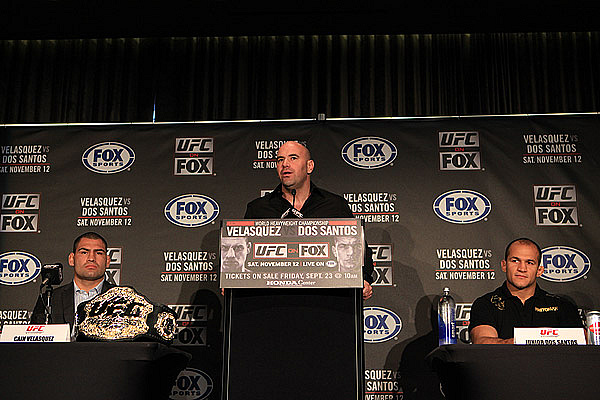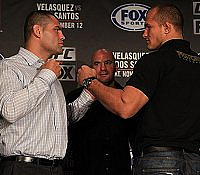Sherdog’s 2011 Story of the Year: UFC, Fox’s 7-Year Hitch

The
UFC landing on Fox instantly changed the MMA landscape in 2011. |
Photo: Dave Mandel
It was an idle Thursday afternoon in August. UFC President Dana White, UFC CEO Lorenzo Fertitta, Georges St. Pierre, Rashad Evans, Frankie Edgar and Chuck Liddell gathered in a Beverly Hills television studio. A sports producer who was two months away from winning a Lifetime Achievement Award at the Emmys was also there. Only the media was invited. Joe Rogan was wearing a blazer.
This had to be something big.
Advertisement
It was announced that UFC fight cards would air four times a year, in primetime, on what most years is the most-watched network in America among men ages 18 to 34. The same network that broadcasts the Super Bowl and the World Series unveiled a promotional video that branded UFC fighters “The Heroes of a New Generation.”
It was heady stuff, almost too much to process without the benefit
of hindsight. For all that the UFC signing with Fox means, and all
that it could mean, the deal is Sherdog.com’s “Story of the Year”
for 2011. It could easily end up the story of the decade.
“What we’ve done the last 10 years means nothing compared to the next two years,” White said on the debut of “UFC Tonight” on Fuel TV, part of a slew of new UFC programming that comes with the Fox deal. “We’ve got a lot of work to do. A lot of people are going to be watching now that have never seen the UFC before.”
The UFC coming to Fox was the biggest story in a year that seemed to have a disproportionately large pool of candidates. The UFC blindsided the MMA world with its purchase of competitor Strikeforce in the spring, leading to several fighters jumping ship to the Octagon. Media giant Viacom purchased a majority share in the fledgling Bellator Fighting Championships, an eyebrow-raising investment in the sport. The MMA scene in Japan, once the sport’s center of gravity, depressed considerably, including the apparent end of K-1 after 28 years in business. The UFC hired an attorney to sue New York State in an attempt to overturn the ban on MMA there. Fedor Emelianenko fell from his perch, Dan Henderson climbed back atop his and Jon Jones had the most remarkable 12 months any mixed martial artist ever has.

Eric
Shanks File Photo
The UFC’s landmark Fox deal
sent shockwaves through the sport.
“Creating stars that people care about -- and not just one star at a time but multiple stars that people actually care about -- that’s what sustains the interest in the sport first and foremost,” Fox Sports President Eric Shanks told the Sherdog Radio Network’s “Rewind” program shortly after the deal was
announced.
Then the fact that you put on really consistent, really upscale matches and performances and fights from all those stars.”
The first fighter to seize the spotlight was Junior dos Santos, who, on Nov. 12, knocked out Cain Velasquez in 64 seconds to become heavyweight champion in the inaugural fight on Fox. It was the most-viewed bout and overall broadcast in the history of MMA on American television, peaking at 8.8 million viewers during the title fight. Boxing has not done a bigger audience since 2003. Among Men 18-34, a key demographic to advertisers and networks, the one-fight event finished second behind a college football game as the most watched show on all of television that Saturday. The broadcast also did tremendous numbers on Fox Sports Deportes and on network television in Brazil.
While the main event was truncated, the broadcast, which also harped on the fight between heavyweight contenders Alistair Overeem and Brock Lesnar, provided a glimpse of the UFC’s philosophy for the Fox specials: use the unprecedented exposure to introduce or establish challengers who will go for gold on pay-per-view, the UFC’s bread-and-butter source of cash. The next FOX special, on Jan. 28 in Chicago, will feature Rashad Evans vs. Phil Davis to likely decide a challenger for Jones on pay-per-view and Chael Sonnen vs. Mark Munoz and Michael Bisping vs. Demian Maia to decide a challenger for a pay-per-view crack at Anderson Silva.

Sherdog.com
Dos Santos seized the Fox spotlight.
All was right in Zuffaland, however, when the ratings came in and showed the UFC had eclipsed any other MMA fight that had been on network television, including the record-holding Kimbo Slice vs. James Thompson fight on CBS in 2008.
The Fox deal promises to put the UFC on par with other major sports, not only from a television platform perspective but also from a revenue perspective. While an improvement over the reported $35 million the UFC was receiving annually from Spike TV, the $90-100 million from Fox is still a far cry from the kind of cash that allows other pro sports leagues to thrive solely off television licensing. If the UFC can grow its ratings appreciably on Fox over the next seven years, it could be in a position to command rights fees on the order of Major League Baseball ($702 million) or the National Basketball Association ($930 million) for fights that are free to the public.
It may sound like a tall order, but consider how much the UFC grew the value of its product in just six years on Spike. The company had to pay all the production costs for the first season of “The Ultimate Fighter” just to get on the air. By the time Season 10 hit just four years later, the thought was that Spike would not be able to afford the UFC anymore, as Spike TV President Kevin Kay explained in an interview on the Sherdog Radio Network “Rewind.”
“I think, to be realistic, we’ve always thought that there might be a time that we wouldn’t be in the UFC business anymore, just because the rights fees might become astronomical,” Kay said. “I think if you look back at ‘The Ultimate Fighter 10,’ the Kimbo [Slice] year when the ratings kind of skyrocketed, that was the moment where I thought, like, this is good news and bad news. The good news is we’d love to have these ratings all the time. The bad news is it’s not likely that it’s going to repeat at that level any time; it was kind of an anomaly. And the other part of the bad news is it’s just going to raise the price again. That’s the way the business runs.”
While the UFC will not ever outgrow Fox’s financial reserve, it has a chance over the next seven years to foster a bidding war for its content and as much as quadruple its money. If it plays out that way, we will look back on the August 2011 press conference in Beverly Hills as the day the sport took the definitive step in carving a permanent spot in the U.S. sports culture.
Related Articles






